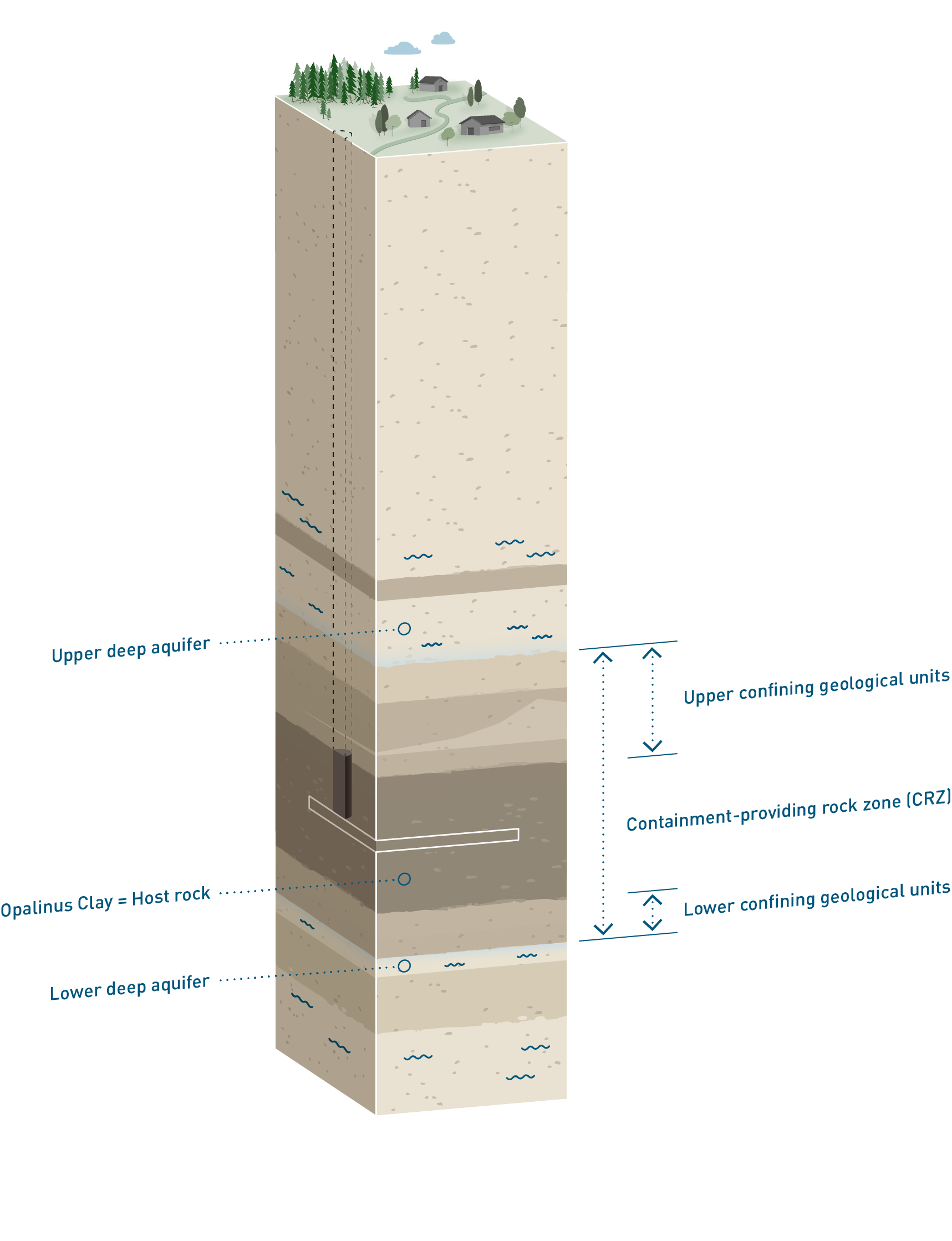In line with the Swiss legal and regulatory framework, as well as national and international principles and practice (see Chapter 2), the repository provides safety by means of multiple geological and engineered barriers, i.e., it is a multi-barrier system. These barriers operate passively, meaning that, after closure of the repository, no further measures, such as maintenance, control, or monitoring, are required to ensure post-closure safety. This relieves future generations of the burden of having to manage or monitor the repository. The individual barriers contribute to so-called safety functions of the repository system, which together ensure a robust system, as discussed below in Sections 3.2.2 and 3.2.3.
Waste is disposed of in waste emplacement rooms, located deep underground within the Opalinus Clay, between its confining geological units (Fig. 3‑2). The innermost engineered barriers for HLW disposal consist of spent fuel (SF) assemblies with fuel rods (UO2 or mixed oxide fuel (MOX) pellets in cladding tubes) and vitrified HLW from reprocessing of SF (RP-HLW), packaged in steel canisters (NTB 24-20, Nagra 2024d). These HLW disposal canisters are emplaced in drifts, which are subsequently backfilled with a buffer material and sealed. For L/ILW disposal, waste packages for L/ILW are placed inside disposal containers, which are in turn emplaced in caverns that are backfilled with cement-based mortar. The inventory of the waste to dispose of is summarised in Section 5.3.1 and described in detail in NTB 22‑05 (Nagra 2023b).
The geological barrier is of primary importance due to the excellent qualities and long-term geological stability of the containment-providing rock zone (CRZ) (Chapter 5 in NTB 24-17, Nagra 2024i). The CRZ includes the Opalinus Clay host rock, as well as the geological units above and below the host rock layer with similarly favourable properties. The CRZ is delimited in the course of the site selection process according to ENSI 33/649 (ENSI 2018) and documented in NAB 24-01 Rev. 1 (Nagra 2024c).
The Opalinus Clay formation is characterised by:
-
A fine and homogeneous pore structure with a very low hydraulic conductivity. This ensures that water movement in this clay formation is limited, and that radionuclide migration is essentially diffusion-dominated.
-
A high clay-mineral content. This results in a high sorption capacity for many radionuclides, thereby delaying their migration through the clay formation.
-
A high self-sealing capacity. This means that any fractures that may form in the clay formation will rapidly close.
The geological units above and below the Opalinus Clay, albeit with a lower or more heterogeneous clay mineral content, contribute further to the retardation and slow transport of radionuclides.
The depth of the geological barrier is sufficient to limit any potential impact of events and processes at the surface, including erosion, on the safety-related properties of the Opalinus Clay itself and its confining geological units.
The geological barrier is complemented by a mutually compatible set of engineered barriers.
A key role of the engineered barriers is the minimisation and mitigation of disturbances to the CRZ. Such disturbances are inevitably caused by the waste and its emplacement, including, for example, the effects of heat generated by the waste and the disturbance to the rock caused by the excavation and ventilation of underground openings. The engineered barriers around the waste are expected to provide a period of complete containment for at least as long as the heat generated by the waste has significant potential to affect transport processes in the surrounding rock. Eventual release of radionuclides and migration through the multi-barrier system cannot, however, be excluded, although most radionuclides will remain immobilised in the waste packages and waste containers until they decay (see Section 5.4).

Fig. 3‑2:Placement (white rectangle) of the repository deep underground within the Opalinus Clay, between its confining geological units
Furthermore, the radionuclides that are released will migrate only slowly towards the surface environment, with substantial attenuation by radioactive decay, first within the engineered barriers and then, for any that migrate through these barriers, within the surrounding geological barrier.
The location of the deep geological repository will be such that the risk of future inadvertent human intrusion is small. Nonetheless, inadvertent human intrusion or disturbance of the repository in the distant future cannot be completely excluded, and thus repository design features that mitigate their potential impact also form part of the current safety concept.

